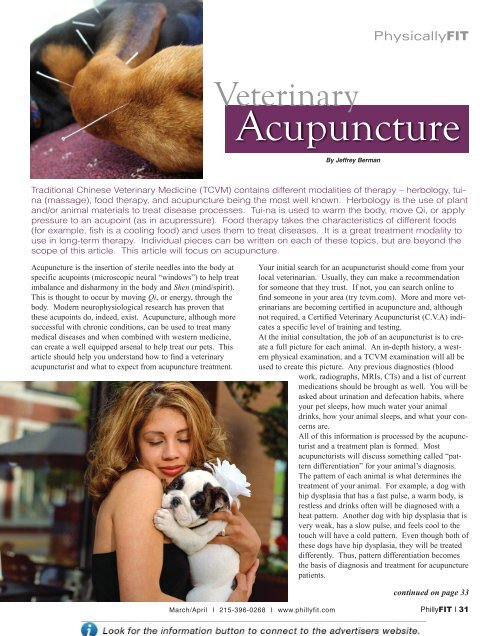cover 0708.qxd - PhillyFIT Magazine
cover 0708.qxd - PhillyFIT Magazine
cover 0708.qxd - PhillyFIT Magazine
You also want an ePaper? Increase the reach of your titles
YUMPU automatically turns print PDFs into web optimized ePapers that Google loves.
PhysicallyFIT<br />
Veterinary<br />
Acupuncture<br />
By Jeffrey Berman<br />
Traditional Chinese Veterinary Medicine (TCVM) contains different modalities of therapy – herbology, tuina<br />
(massage), food therapy, and acupuncture being the most well known. Herbology is the use of plant<br />
and/or animal materials to treat disease processes. Tui-na is used to warm the body, move Qi, or apply<br />
pressure to an acupoint (as in acupressure). Food therapy takes the characteristics of different foods<br />
(for example, fish is a cooling food) and uses them to treat diseases. It is a great treatment modality to<br />
use in long-term therapy. Individual pieces can be written on each of these topics, but are beyond the<br />
scope of this article. This article will focus on acupuncture.<br />
Acupuncture is the insertion of sterile needles into the body at<br />
specific acupoints (microscopic neural “windows”) to help treat<br />
imbalance and disharmony in the body and Shen (mind/spirit).<br />
This is thought to occur by moving Qi, or energy, through the<br />
body. Modern neurophysiological research has proven that<br />
these acupoints do, indeed, exist. Acupuncture, although more<br />
successful with chronic conditions, can be used to treat many<br />
medical diseases and when combined with western medicine,<br />
can create a well equipped arsenal to help treat our pets. This<br />
article should help you understand how to find a veterinary<br />
acupuncturist and what to expect from acupuncture treatment.<br />
Your initial search for an acupuncturist should come from your<br />
local veterinarian. Usually, they can make a recommendation<br />
for someone that they trust. If not, you can search online to<br />
find someone in your area (try tcvm.com). More and more veterinarians<br />
are becoming certified in acupuncture and, although<br />
not required, a Certified Veterinary Acupuncturist (C.V.A) indicates<br />
a specific level of training and testing.<br />
At the initial consultation, the job of an acupuncturist is to create<br />
a full picture for each animal. An in-depth history, a western<br />
physical examination, and a TCVM examination will all be<br />
used to create this picture. Any previous diagnostics (blood<br />
work, radiographs, MRIs, CTs) and a list of current<br />
medications should be brought as well. You will be<br />
asked about urination and defecation habits, where<br />
your pet sleeps, how much water your animal<br />
drinks, how your animal sleeps, and what your concerns<br />
are.<br />
All of this information is processed by the acupuncturist<br />
and a treatment plan is formed. Most<br />
acupuncturists will discuss something called “pattern<br />
differentiation” for your animal’s diagnosis.<br />
The pattern of each animal is what determines the<br />
treatment of your animal. For example, a dog with<br />
hip dysplasia that has a fast pulse, a warm body, is<br />
restless and drinks often will be diagnosed with a<br />
heat pattern. Another dog with hip dysplasia that is<br />
very weak, has a slow pulse, and feels cool to the<br />
touch will have a cold pattern. Even though both of<br />
these dogs have hip dysplasia, they will be treated<br />
differently. Thus, pattern differentiation becomes<br />
the basis of diagnosis and treatment for acupuncture<br />
patients.<br />
continued on page 33<br />
March/April I 215-396-0268 I www.phillyfit.com <strong>PhillyFIT</strong> I 31
















